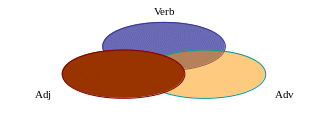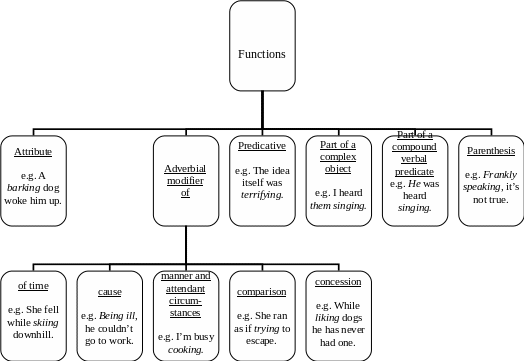
- •Содержание
- •Введение
- •Раздел I. Введение.
- •Theoretical grammar as a brunch of linguistics
- •Systemic conception of language
- •Discrimination of Language and Speech
- •Hierarchy of Language Levels
- •Language Units and Speech Units
- •Systemic Relations in Language
- •Morphology morphemic structure of the word
- •Traditional Classification of Morphemes
- •Allo-emic Classification of Morphemes
- •Types of Distribution
- •Categorial structure of the word
- •Grammatical means
- •Grammatical forms
- •Inflextional forms
- •Inner inflextional forms
- •Neutralization
- •Transposition
- •Grammatical classes of words
- •Parts of speech
- •Nominative parts of speech
- •Particles
- •Word classes
- •4 Major classes of words 15 Form-classes
- •Noun and its categories semantic features of the noun
- •Morphological features of the noun
- •Categories of the Noun
- •Category of Number
- •Indiscreteness is explicitly expressed
- •Types of Oppositional Reduction
- •Category of Case
- •Case Theories
- •Category of Gender
- •Category of Article Determination
- •Syntactic features of the noun
- •Verb and its categories classifications of verbs
- •Category of Finitude
- •Categories of the verb Categories of Person and Number
- •Category of Aspect
- •Evolution of Views
- •Category of Retrospect
- •Category of Voice
- •Category of Mood
- •The Infinitive
- •The Gerund
- •Double Nature of the Gerund
- •The Participle
- •Adjective semantic features of the adjective
- •Morphological features of the adjective
- •Adjectives that do not Form Degrees of Comparison
- •Syntactic features of the adjective
- •Order of Adjectives before a Noun
- •Stative symantic features of the stative
- •Morphological features of the stative
- •Syntactic features of the stative
- •The Adjective and the Stative
- •Adverb semantic features of the adverb
- •Morphological features of the adverb
- •Syntactic features of the adverb
- •Syntax word-group theory
- •Sentence: general
- •Classification of Sentences
- •Communicative Classification of Sentences
- •Simple sentence
- •Sentence parts
- •Principle sentence parts subject
- •Predicate
- •The simple predicate can be of two types: verbal and nominal. The simple verbal predicate can be expressed in two ways (Fig. 122).
- •Compound Verbal Modal Predicate
- •Compound Nominal Predicate
- •Secondary sentence parts object
- •Attribute
- •Apposition
- •Adverbial modifier
- •Independent elements of the sentence
- •Composite sentence
- •The means of combining clauses into a polypredicative sentence are divided into syndetic, I. E. Conjunctional, and asyndetic, I. E. Non-conjunctional (Fig. 144).
- •Compound sentence
- •There exist two different bases of classifying subordinate clauses: the first is functional, the second is categorical.
- •Glossary of linguistic terms
- •Refferences
- •Заключение
- •454080 Г. Челябинск, пр. Ленина, 69
- •454080 Г. Челябинск, пр. Ленина, 69
The Participle
The participle is a non-finite form of the verb. There are two forms of the participle – participle I and participle II (Fig. 75).

Fig. 75
The present participle is the non-finite form of the verb which combines the properties of the verb with those of the adjective and adverb, serving as the qualifying-processual name. Since it possesses some traits both of adjective and adverb, the present participle is not only dual, but triple by its lexico-grammatical properties, which is displayed in its combinability, as well as in its syntactic functions (Fig. 76).
The past participle is the non-finite form of the verb which combines the properties of the verb with those of the adjective, serving as the qualifying-processual name.

Fig. 76
The verbal character of participle I is manifested morphologically in the categories of voice and perfect and syntactically in its combinability. Thus, like the other non-finites, it may combine: with a noun or a pronoun as direct, indirect or prepositional object; with an adverb or a prepositional phrase as an adverbial modifier; with a noun or adjective as a predicative. The adjectival and adverbial features of participle I are manitested in its syntactical functions as an attribute and an adverbial modifier (Table 11).
The adjectival nature of participle II manifests itself in its function in the sentence, which is usually that of either attribute or predicative. The verbal character of participle II is manifested in its combinability (Table 11).
Table 11
Triple Nature of the Participle
Adjectival and adverbial character |
Verbal character |
1. It can be used as an attribute e.g. The reading hall was empty. e.g. He stared at his name written on the wall. |
1. Participle I can take a direct object (transitive verbs) e.g. When reading the book, she couldn’t help laughing. |
2. It can be used as an adverbial modifier e.g. When reading the book, she couldn’t help laughing. e.g. When asked this question, I always feel embarrassed. |
2. Both Participles can be modified by an adverb e.g. Turning slowly she went to her room. e.g. Deeply surprised, she went to her room. |
3. Participle I has tense distinctions and voice distinctions (transitive verbs) |
The present participle distinguishes the grammatical categories of retrospective coordination and voice (Fig. 77).
Fig. 77
Thus, the categorial paradigm of the present participle of the objective verb includes four forms (Table 12).
Table 12
Forms of Participle I
|
Active |
Passive |
Indefinite |
doing |
being done |
Perfect |
having done |
having been done |
The past participle is a single form, having no paradigm of its own. By way of the paradigmatic correlation with the present participle, it conveys implicitly the categorial meaning of the perfect and the passive.
The self-positional present participle performs the functions of the predicative (occasional use, and not with the pure link be), the attribute, the adverbial modifier of various types. It may be used alone or as headword of a participial phrase, or else as part of a predicative construction (Fig. 78).
As part of the sentence participle II may stand alone or be the headword of a participial phrase. It may function as an attribute (close or detached), predicative, or as an adverbial modifier (Fig. 79).
The participle may function as part of a predicative construction, entering into a predicative relationship with some nominal element and forming a syntactical unit with it.
The present participle can build up semi-predicative complexes of objective and subjective types, as well as absolute complexes (Fig. 80).
Participle II forms the second (verbal) element of the objective with the participle construction and of the absolute participial construction in two variants: non-prepositional and prepositional (Fig. 80).
Fig. 78

Fig. 79


Fig. 80
